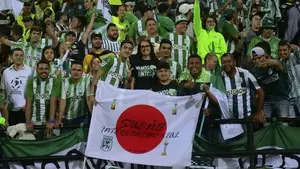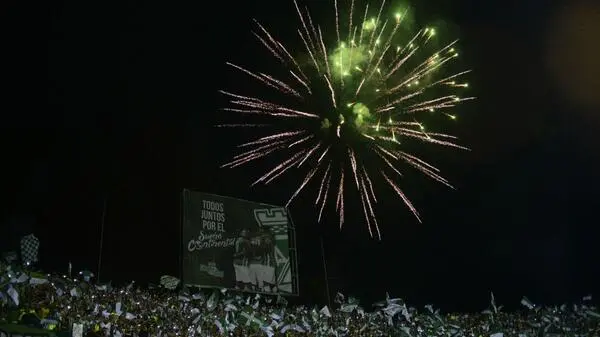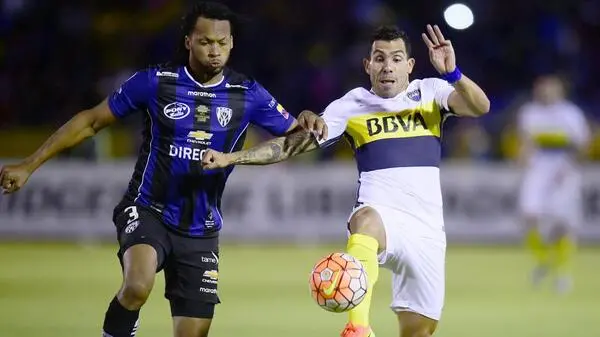It was a scene that no European player can ever dream of experiencing. Almost 40,000 Atletico Nacional were packed into the Estadio Atanasio Girardot to cheer their side on, a sea of green hoping for the joy of Copa Libertadores glory.
The fireworks started long, long before the final whistle signalled victory, as the Medellin side triumphed over Independiente del Valle 1-0 in the final second leg to become the first Colombian team to win South America's biggest trophy twice. It was the culmination of a gripping rollercoaster ride to the title that laid bare how the slick, polished Champions League cannot compare in terms of pure emotion.
The European competition, make no mistake, is perhaps the finest exhibition of football on the planet. From Lionel Messi to Cristiano Ronaldo it plays host to the best players in the world, assembled by teams boasting budgets as large as that of many small nations. But that injection of funds, the disparity that afflicts the game, make the Champions League a little more predictable with every year that passes.
Over in South America, meanwhile, the trend is exactly in the opposite direction. No one team, or group of elite sides can dominate the Libertadores, which makes it an intriguing competition from the first game to the last.



Both Nacional and Independiente del Valle played with an intensity and passion over the two legs that was frankly astounding. Even at 1-0 up in both ties, the hosts refused to sit on their lead, and peppered the Ecuadorians with attempts led by the livewire youngster Marlos Moreno and powerful striker Miguel Borja, the hero and top scorer of the Medellin giants.
Independiente, meanwhile, the fairytale team of the competition, knew their limitations but kept going until the very last seconds as they bid to grab one more upset. It was not to be; but having shocked South American by downing heavyweights Boca Juniors, River Plate and Pumas on the way to the final, all three with budgets far higher than the Quito club, they left with their heads held high.
To tell the truth, neither club were 'supposed' to be in Wednesday's final. Each was dwarfed by their semi rival, both in history and in spending power. But South America's aristocrats were toppled. Sao Paulo had no answer for Nacional's intensity as they were beaten in both legs, and the shock of the decade followed when tiny Independiente slayed Carlos Tevez's Boca. No result is assured in the Copa, and no team respect reputations.
In the last eight editions of the Copa Libertadores, 16 different clubs from six countries have disputed the final. In that same period the Champions League has seen only nine teams make the showpiece, all of which came from the 'big-four' leagues of England, Germany, Italy and Spain. Aside from Paris Saint-Germain, inflated by a multi-millionaire owner, it is difficult to imagine any other nation breaking into that group in the near-future.

Any team wishing to lift the Libertadores must contend with a hellish schedule, travelling often the equivalent to a London-Beijing return flight midweek in order to meet continental and domestic obligations. There is also the danger of being a victim of one's own success. Winning South American teams are usually picked apart remorselessly by richer suitors, with the best players winning their ticket to improve incomes elsewhere. Those left behind have to pick up the pieces season-by-season, next to unfamiliar names in the dressing room - and on a football-mad continent, there is no time for mistakes.
They face tropical heat, deathtrap roads - Huracan midfielder Patricio Toranzo missed the entire season after a foot injury sustained when the team's bus overturned in Venezuela - and, most notoriously, the altitude of Quito, La Paz and other major cities. All this for wages a fraction of what even the most mediocre Premier League player picks up, and in conditions most in Europe can only imagine.
But those sacrifices are small change to a group of players used to fighting. Nacional's solitary goalscorer Borja was saved from a life in the ultra-violent ranks of Colombian paramilitaries by football, while the inspirational Independiente goalkeeper Librado Azcona had spent almost his entire career in obscurity before his brilliant Libertadores performances sent his name across the continent. Such stories pepper each squad, making their victory all the more sweeter when it finally arrives.
South American football has its limitations. A two-legged final is a necessary evil due to the financial impossibility for many fans to travel to a neutral venue thousands of kilometres away, making the rather clumsy format vital to ensure they can see at least once their heroes up close. Violence both on and off the pitch is still an issue, and while the 2016 Libertadores was refreshingly free of serious incidents police had to be called on several occasions to separate players when tensions boiled over.
Just last year, a hideous pepper spray attack from the stands caused Boca to be thrown out of the tournament. The terraces still largely police themselves from Argentina to Venezuela, and when authorities attempt to intervene the results are often unpleasant. The play, too, is much less refined than in most top-level European games, with frequent, often jaw-dropping mistakes appearing at times.
But in a world where money dominates the sport and, more often than not, dictates results, the Libertadores keeps its romance alive long after the Champions League became a private party for Europe's elites. The likes of Red Star, Steaua Bucharest, Ajax and Celtic can no longer dream of taking down the big boys, but for their counterparts across the Atlantic, nothing is impossible....
- Goal